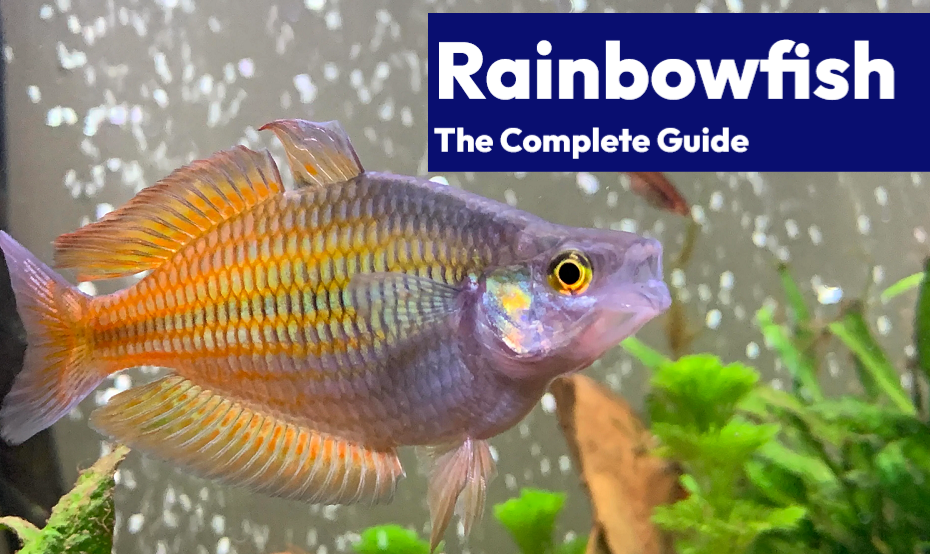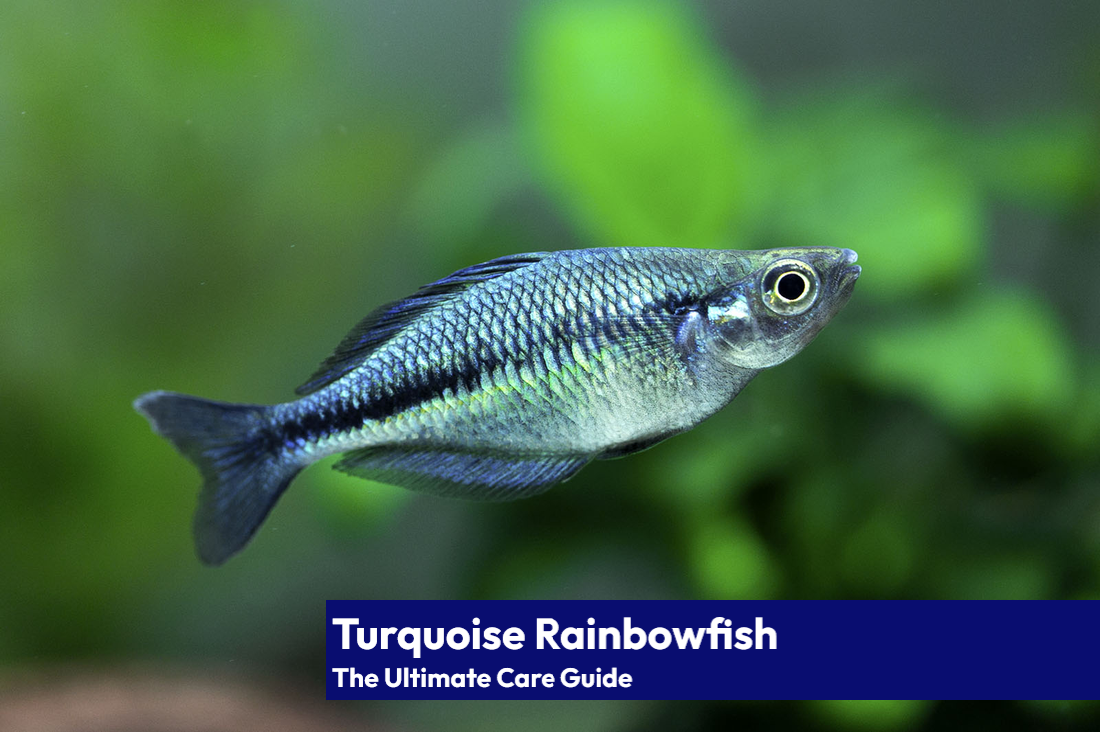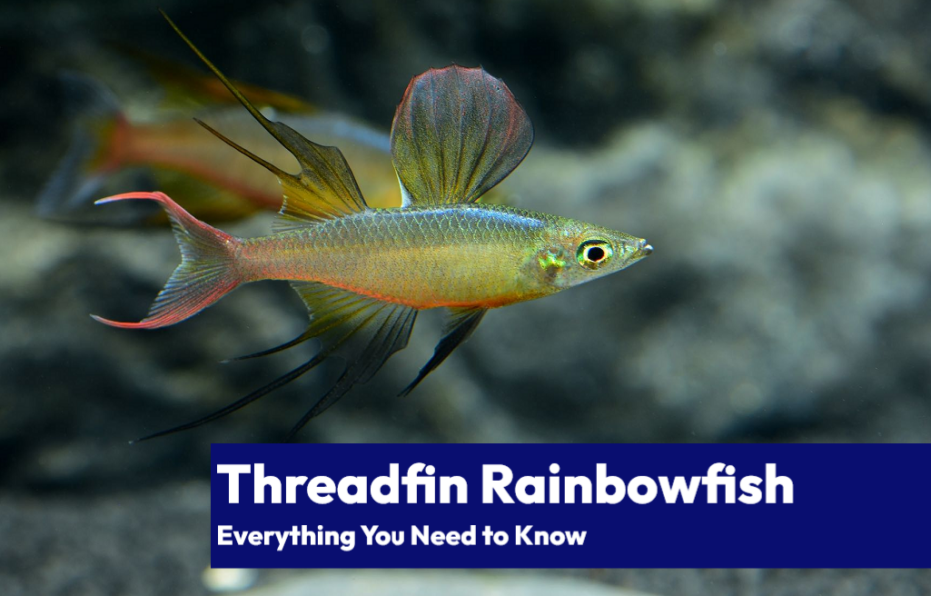Have you ever gazed into an aquarium and felt like something was missing? It might just be a Rainbowfish! These bright, energetic fish are the perfect addition to any freshwater community aquarium. In this article we’ll take you on a journey through the world of Rainbowfish and look at the 15 most popular types found in the hobby, their appearance and behavior, habitat requirements and more.
With their incredible coloration and unique personalities, rainbowfish are sure to be the centerpiece of your aquarium, drawing attention from all who see them. Whether you’re an experienced aquarist or just starting out, our guide has everything you need to create the perfect habitat for these unique fish.
*Note: The below care data is generalized and will accommodate most species of rainbowfish.
| Care Data Point | Description |
|---|---|
| Scientific Family | Melanotaeniidae |
| Minimum Tank Size | 20 gallons (76 liters) for small species, 30 gallons (114 liters) for larger species |
| Water Temperature | 72-82°F (22-28°C) |
| pH Level | 7.0-8.0 |
| Water Hardness | 9-12 dGH |
| Diet | Omnivorous; provide a varied diet of live, frozen, freeze-dried, and flake food |
| Social Behaviour | Peaceful to Semi-aggressive, depending on species and individual personality |
| Breeding | Breeds readily in suitable water conditions |
| Average Lifespan | 4-6 years |
| Compatibility | Compatible with other peaceful fish in a community tank |
Appearance
Rainbowfish are known for their stunning, iridescent scales that shimmer and shine in the light. They come in a wide variety of shapes, colors, including blue, green, red, and yellow, and some species even have metallic or neon coloring.
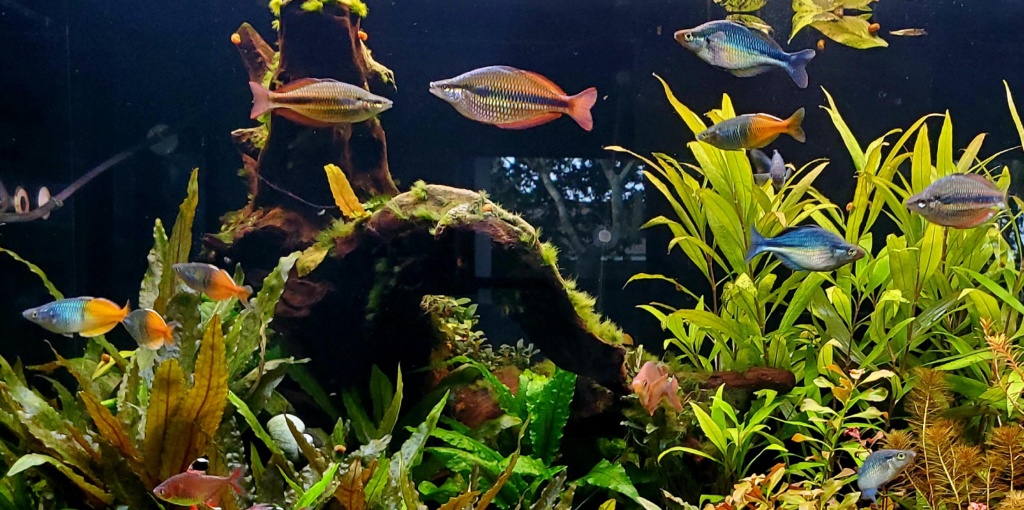
Their fins are also brightly colored and can be long and flowing or short and rounded, depending on the species. Rainbowfish have a sleek and slender body, making them excellent swimmers, and their scales are smooth and reflective, giving them a mesmerizing appearance.
Lifespan
Rainbowfish are hardy fish with an average lifespan of 4-6 years, although some species can live up to 8 years with proper care. With their bright colors and playful personalities, rainbowfish are sure to bring joy and excitement to your aquarium for many years to come.
Average Size and Growth Rate
The average size of rainbowfish varies depending on the species, but most grow to be 2-4 inches (5-10 cm) in length. They have a fast growth rate, most reaching their full size in just a few months with proper care.
Tank Size
For a single rainbowfish, a 20 gallon (76-liter) tank is recommended. For a small group, a 30 gallon (114-liter) tank is appropriate, and for a large group, a 50 gallon (189-liter) tank or larger is recommended.
Water Parameters
Rainbowfish prefer a neutral to alkaline pH of 7.0-8.0, a water hardness of 9-12 dGH, and a temperature of 72-82°F (22-28°C). It is important to maintain stable water parameters to keep your rainbowfish healthy and happy.
Types of Rainbowfish
There are over 70 species of rainbowfish in existence, but only a small number of those are actively found for sale in the aquarium hobby. These fish are native to Australia, New Guinea, and nearby islands, and are most frequently found in Lake Wanam, the Aru Islands, and other bodies of water in the Northern Territory of Australia.
Below you can see the top 15 types of rainbowfish and ranked them by popularity, starting with the most popular.
Threadfin Rainbowfish

| Common Name | Scientific Name | Size (inches) | Size (cm) |
|---|---|---|---|
| Threadfin Rainbowfish | Iriatherina werneri | 1.5 | 3.8 |
Australian Rainbowfish

| Common Name | Scientific Name | Size (inches) | Size (cm) |
|---|---|---|---|
| Australian Rainbowfish | Melanotaenia fluviatilis | 4 | 10 |
Boesemani Rainbowfish

| Common Name | Scientific Name | Size (inches) | Size (cm) |
|---|---|---|---|
| Boesemani Rainbowfish | Melanotaenia boesemani | 3.5 | 9 |
Dwarf Neon Rainbowfish (Praecox Rainbowfish)

| Common Name | Scientific Name | Size (inches) | Size (cm) |
|---|---|---|---|
| Dwarf Neon Rainbowfish | Melanotaenia praecox | 1.5 | 3.8 |
Red Neon Blue Eye Rainbowfish

| Common Name | Scientific Name | Size (inches) | Size (cm) |
|---|---|---|---|
| Red Neon Blue Eye Rainbowfish | Pseudomugil luminatus | 1.5 | 3.8 |
Turquoise Rainbowfish

| Common Name | Scientific Name | Size (inches) | Size (cm) |
|---|---|---|---|
| Turquoise Rainbowfish | Melanotaenia lacustris | 2.5 | 6.4 |
Celebes Rainbowfish

| Common Name | Scientific Name | Size (inches) | Size (cm) |
|---|---|---|---|
| Celebes Rainbowfish | Marosatherina ladigesi | 2.5 | 6.4 |
Furcata Rainbowfish (Forktail Rainbowfish)

| Common Name | Scientific Name | Size (inches) | Size (cm) |
|---|---|---|---|
| Furcata Rainbowfish | Bedotia geayi | 4 | 10.2 |
Madagascar Rainbowfish
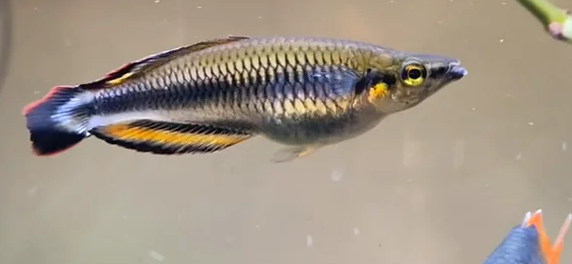
| Common Name | Scientific Name | Size (inches) | Size (cm) |
|---|---|---|---|
| Madagascar Rainbowfish | Bedotia madagascariensis | 4 | 10.2 |
Millennium Rainbowfish

| Common Name | Scientific Name | Size (inches) | Size (cm) |
|---|---|---|---|
| Millennium Rainbowfish | Glossolepis pseudoincisus | 3 | 7.6 |
Kamaka Rainbowfish
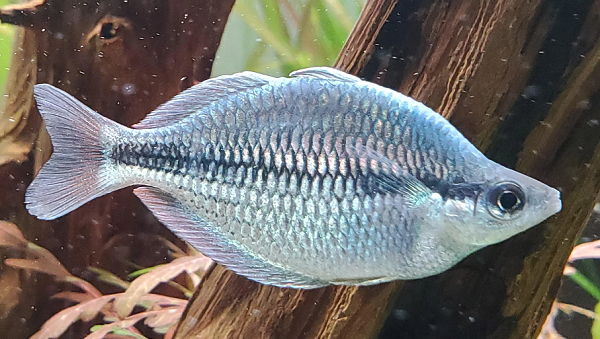
| Common Name | Scientific Name | Size (inches) | Size (cm) |
|---|---|---|---|
| Kamaka Rainbowfish | Melanotaenia kamaka | 4 | 10.2 |
Lake Kutubu Rainbowfish

| Common Name | Scientific Name | Size (inches) | Size (cm) |
|---|---|---|---|
| Lake Kutubu Rainbowfish | Melanotaenia lacustris | 4 | 10.2 |
Parkinsoni Rainbowfish

| Common Name | Scientific Name | Size (inches) | Size (cm) |
|---|---|---|---|
| Parkinsoni Rainbowfish | Melanotaenia parkinsoni | 3 | 7.6 |
Emerald Rainbowfish (Lake Wanam Rainbowfish)

| Common Name | Scientific Name | Size (inches) | Size (cm) |
|---|---|---|---|
| Emerald Rainbowfish | Glossolepis wanamensis | 3 | 7.6 |
Banded Rainbowfish (Cato river)

| Common Name | Scientific Name | Size (inches) | Size (cm) |
|---|---|---|---|
| Banded Rainbowfish (Cato river) | Melanotaenia trifasciata | 3 | 7.6 |
Diet
Rainbowfish are omnivores and do well on a diet of both dry and wet foods, such as flakes, pellets, and frozen or live foods. It is important to provide a varied diet to ensure they receive all of the necessary nutrients.
| Food Type | Description |
|---|---|
| Brine Shrimp | Rich in protein and essential amino acids, good for promoting growth and color. |
| Daphnia | A small, nutritious live food that helps provide necessary vitamins and minerals. |
| Bloodworms | A protein-rich food that is good for promoting overall health and vitality. |
| Mosquito Larvae | Rich in essential fatty acids, good for promoting healthy skin and fins. |
| Tubifex Worms | A high-protein food that helps support immune system function and overall health. |
| Blackworms | A soft, nutritious food that is easy for Rainbowfish to digest and provides vital nutrients. |
| Artemia (Baby Brine Shrimp) | A small, nutritious food that provides essential vitamins, minerals, and amino acids. |
| Worms | A protein-rich food that provides essential nutrients for growth and overall health. |
| Flakes | A convenient and easily accessible food that provides essential vitamins, minerals, and nutrients. |
| Algae Wafers | A slow-sinking food that provides a balanced diet and promotes healthy digestion. |
Housing Requirements
Rainbowfish need plenty of hiding places and swimming space in their tank. Live or artificial plants, caves, and other decorations can provide hiding places, while open swimming areas should also be available. A strong and efficient filtration system is also necessary to keep the water clean and healthy.
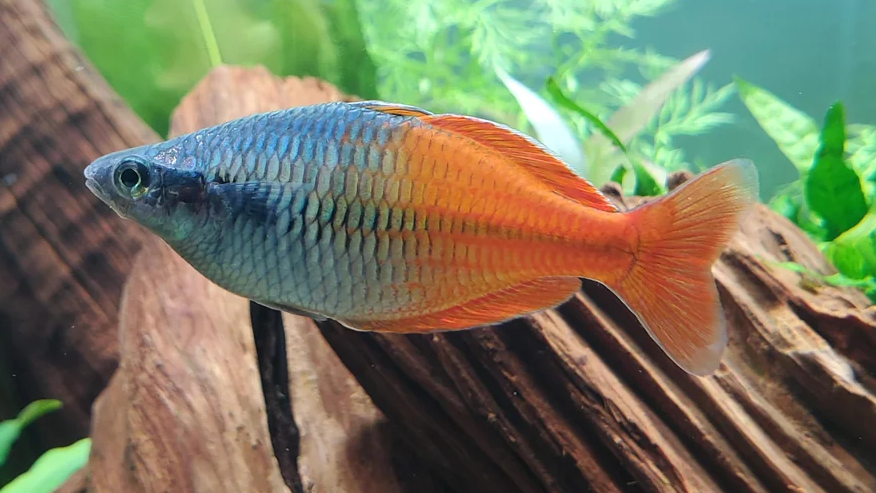
Behavior and Temperament
Rainbowfish are active and energetic fish that love to swim and play. They are generally peaceful and can be kept with other peaceful fish species. However, it is important to provide plenty of space to prevent aggression.
Breeding
Breeding rainbowfish is not difficult, but it does require a few specific conditions to be met. We’ve created an easy to follow guide to help you get started breeding these dazzling fish.
Step 1: Setting Up the Breeding Tank
When breeding Rainbowfish, it is important to have a separate tank specifically for breeding. This tank should be at least 20 gallons (75.7 liters) in size, with a water temperature of around 76-80°F. The pH level should be between 7.0-8.0, and the water should be well-oxygenated.
Step 2: Choosing the Right Rainbowfish
Rainbowfish come in many different varieties, so it is important to choose the right species for breeding. Look for healthy, mature fish that are at least 2 years old. Make sure to choose fish of both sexes, with a ratio of 1 male to 2-3 females.
Step 3: Conditioning the Fish
In order to increase the chances of successful breeding, it is important to condition the Rainbowfish before breeding. This can be done by feeding them a varied diet of high-quality food, such as live or frozen foods, and providing them with plenty of hiding places in the tank.
Step 4: Spawning
Rainbowfish are egg-layers, and the female will lay her eggs on flat surfaces in the tank, such as leaves or rocks. The male will then fertilize the eggs. It is important to keep a close eye on the eggs, as they can be susceptible to fungus and other diseases.
Step 5: Raising the Fry
Once the eggs have hatched, it is important to provide the fry with plenty of food and a clean living environment. Live or frozen foods, such as brine shrimp, are ideal for feeding the fry. As they grow, they can be gradually transitioned to a diet of pellets or flakes.
Step 6: Separating the Fry
As the fry grow, it is important to separate them from the adult Rainbowfish to avoid aggression and competition for food. This can be done by transferring them to a separate tank or using a breeding net.
Step 7: Continuing Care
Continuing to provide proper care for the fry is essential for their health and growth. This includes maintaining the water quality, providing a balanced diet, and monitoring for any signs of illness or disease.
Pro Tips:
- Cover the breeding tank with layer of gravel and java moss or spawning mops. Aeration is necessary.
- Rainbowfish breed in early mornings, with the male courting the female by swimming rapidly with fully erect fins. Spawning starts when the two fish take position next to each other and release their eggs.
- Eggs are adhesive and may range from less than 5 to over 30. To prevent the parents from eating the eggs, move them to a separate fry rearing container with water from the breeding aquarium.
- When the eggs hatch, the fry will be ~4mm long and will consume their yolk sacs. Feed them infusoria or liquid fry food, then brine shrimp and microworms as they grow. Maintain water quality with frequent water changes and removing uneaten food.
Tankmates
Rainbowfish can be kept with a variety of other peaceful fish species, such as tetras, rasboras, and gouramis. It is important to choose tankmates that have similar water parameters and temperaments to ensure a harmonious environment.
| Fish | Description |
|---|---|
| Neon Tetra | Small, vibrant and peaceful fish that will add a pop of color to your tank. They have similar water conditions and behavior to Rainbowfish. |
| Guppy | Active and hardy fish that are a great addition to any community tank. Their bright colors can complement the Rainbowfish. |
| Platy | Another hardy and active species that can thrive in the same water conditions as Rainbowfish. They can provide additional movement and interest to the tank. |
| Danios | Fast-swimming fish that will add energy and excitement to the tank. They are also relatively easy to care for and can handle similar water conditions. |
| Mollies | Known for their hardiness and adaptability, Mollies can make a great addition to any community tank. They have a peaceful demeanor and can handle the same water conditions as Rainbowfish. |
| Swordtails | Similar to Platies and Mollies, Swordtails are active and hardy fish that can handle similar water conditions and add a unique touch to the tank. |
| Corydoras Catfish | Bottom-dwelling fish that will help keep the substrate clean and add some variety to the tank. They have a peaceful demeanor and are easy to care for. |
| Kuhli Loach | A unique and interesting addition to any community tank, Kuhli Loaches are active and peaceful fish that can help control pest populations. |
| Harlequin Rasbora | A small and vibrant species that will add a pop of color to the tank. They are active and peaceful, making them a great choice for a community tank. |
| Angelfish | While they are slow-swimming, Angelfish are a beautiful and peaceful species that can complement the Rainbowfish. They are also relatively easy to care for. |
| Bolivian Ram | A beautiful and peaceful species that will add some variety to the tank. They are a good choice for a community tank and have similar water conditions to Rainbowfish. |
| Black Widow Tetra | A small and active species that will add some movement and excitement to the tank. They are peaceful and can handle similar water conditions as Rainbowfish. |
| Rummy Nose Tetra | Another small and active species that will add some color and movement to the tank. They are peaceful and can handle similar water conditions as Rainbowfish. |
| Zebra Danio | A fast-swimming species that will add energy and excitement to the tank. They are peaceful and hardy, making them a great choice for a community tank. |
Diseases and Illnesses
| Illness/Disease | Symptoms | Treatment |
|---|---|---|
| Columnaris | White cottony growth on mouth, fins, and body. Fin rot and wounds that don’t heal. | Antibiotic treatment, improved water quality, and increased aeration. |
| Ich | White spots on body, fins, and gills. Rapid breathing and scratching on objects in the tank. | Increased temperature to 86-90°F (30-32°C) for 7-10 days, aquarium salt, and/or commercial ich medication. |
| Velvet Disease | Gold or yellowish dust-like coating on body and fins. Loss of appetite and lethargy. | Increased temperature to 86-90°F (30-32°C) for 10-14 days, aquarium salt, and/or commercial velvet medication. |
| Fin Rot | Frayed, torn, or missing fins. Bacterial infection can cause darkening or blackening of fins. | Improved water quality, increased aeration, and antibiotics as needed. |
| Parasites | White or yellow spots on body, fins, and gills. Rapid breathing and scratching on objects in the tank. | Improved water quality, increased temperature to 86-90°F (30-32°C), and/or commercial parasite medication. |
| Swim Bladder Disease | Fish swims at an angle or has difficulty swimming upright. | Improved water quality, reduction in feeding, and pea-based diet. |
| Septicemia | Red streaks or patches on fins and body. Loss of appetite and lethargy. | Antibiotic treatment, improved water quality, and increased aeration. |
History and Origin
Rainbowfish, scientifically known as Melanotaeniidae, is a family of freshwater fish that are native to the rivers and streams of the Australasian region. The history and origins of Rainbowfish are fascinating, as they have been around for millions of years and have been the subject of study for many ichthyologists and scientists.
The Rainbowfish family is believed to have originated in the rivers of New Guinea and the surrounding islands. The species is believed to have evolved from a common ancestor that lived in the ancient rivers of the region. American naturalist Dr. Thomas Gill discovered and described this species in 1862.
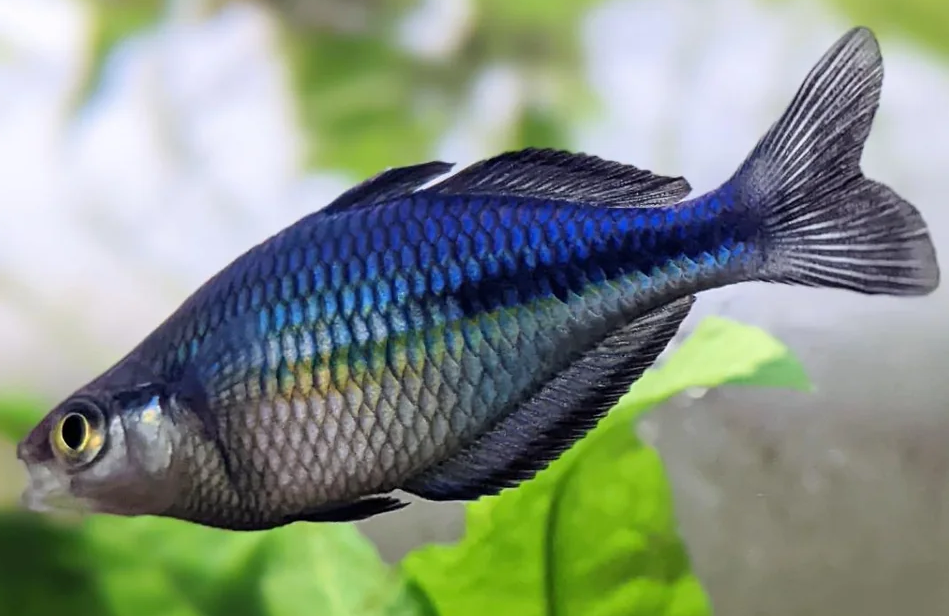
Rainbowfish have a wide range of geographic distribution and can be found in rivers and streams throughout the Australasian region, including Australia, New Guinea, Indonesia, and the Philippines. The species is highly adaptable and can thrive in a variety of habitats, from fast-flowing rivers to slow-moving streams. The Rainbowfish family is also known for its high levels of biodiversity, with over 70 species of Rainbowfish currently recognized.
One of the unique and fun facts about Rainbowfish is that they are able to change their colors to match their environment. This ability is known as “color polymorphism” and is a result of the species’ ability to adjust their skin pigmentation in response to environmental cues. This allows Rainbowfish to blend in with their surroundings, making them less visible to predators.
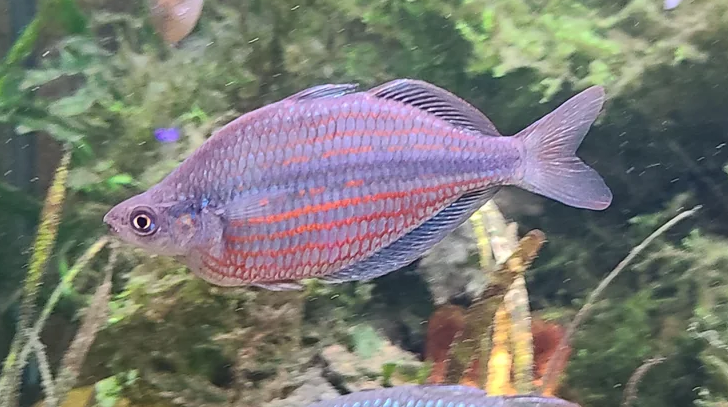
Rainbowfish are also known for their active and social behavior. The species are often found in large schools, and their active behavior and vibrant colors make them a popular choice for aquarium hobbyists. In the wild, Rainbowfish feed on a variety of small aquatic insects and crustaceans, and they are omnivores in captivity, accepting a wide range of foods including flakes, pellets, and frozen or live food.
The popularity of Rainbowfish as aquarium pets has led to the development of many different variants and morphs, including long-finned and short-finned varieties, as well as different color morphs. These variations have been created through selective breeding, and they offer aquarium hobbyists the opportunity to create unique and visually stunning aquarium displays.
Frequently Asked Questions
Q: What is a Rainbowfish?
A: A Rainbowfish is a freshwater fish species known for its vibrant and colorful scales. They are native to Australia and nearby islands.
Q: How long do Rainbowfish live?
A: Rainbowfish can live up to 4-6 years on average with proper care.
Q: What do Rainbowfish eat?
A: Rainbowfish are omnivorous and will eat a variety of foods including flakes, pellets, frozen, and live foods such as brine shrimp and bloodworms.
Q: Can Rainbowfish be kept with other fish species?
A: Rainbowfish are generally peaceful and can be kept with other peaceful fish species. However, they should not be kept with aggressive fish or larger fish that may view them as prey.
Q: How many Rainbowfish should I keep in a tank?
A: It is recommended to keep at least 6 Rainbowfish in a tank, as they are a schooling fish and do better in groups.
Q: Are Rainbowfish easy to care for?
A: Rainbowfish are relatively easy to care for and are a good choice for beginner aquarists as long as they understand these fish prefer alkaline water with moderate to high hardness.
Q: How often should I feed my Rainbowfish?
A: It is recommended to feed Rainbowfish small amounts 2-3 times a day. Overfeeding can lead to poor water quality and health issues.

Tim Priest, a renowned aquarium expert with over 15 years of experience in aquatic gardening and fish education, is dedicated to helping enthusiasts create stunning and thriving aquatic environments. As the founder of LearnTheAquarium.com, Tim shares his wealth of knowledge, passion, and expertise through engaging articles, educational resources, and personalized advice.
Discover the secrets to creating captivating underwater landscapes and maintaining healthy aquatic ecosystems. Join Tim on an exciting journey and let your aquarium adventure begin!
